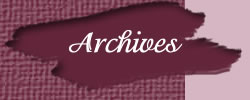
Archives
 |
 |
 |
 |
 |
 |
 |
|
|
Alexander Borkov
Painting
14 april - 10 may 2009
 |
 |
 |
 |
 |
 |
 |
 |
 |
 |
 |
 |
 |
 |
 |
 |
 |
 |
 |
 |
 |
 |
 |
 |
 |
 |
 |
 |
||
Catalogue of exhibition
- Autumn landscape. 2008. Paper, water color. 51È65
- A pine. 2008. Paper, water color. 61È42
- Old tree. 2008. Paper, water color. 46È60
- A stroll. Udelny park. 2009. Paper, water color.72È97
- Vineyards of Toscana. 2006. Paper, water color. 72È97
- Springtime. 2008. Paper, water color. 72È97
- Landscape. 2008. Paper, water color. 72È97
- Olives. Toscana. 2006. Paper, water color. 72È97
- A sunny day. 2006. Paper, acrylic. 72È97
- Landscape. 2007. Paper, acrylic. 72È97
- Novodevichy Monastery. Diptych. 1990. C., oil. 60È160
- Forest lake. 2007. C., acrylic. 50È70
- Meeting under platans. 2008. C., acrylic, oil. 60È70
- Red trees. 2007. C., oil. 50È60
- Pavlovsk. 2007. C., acrylic. 60È70
- Old house. 2007. C., acrylic. 60È70
- Landscape. 2008. C., acrylic. 70È80,
- Sans-Souci. 2001. C., oil. 60È70
- Florence. 2005. C., oil. 50È60
- Night landscape. 1991. C., oil. 50È60
- Old bridge in Novaya Ladoga. 2003. C., oil. 50È50
- Sunset. Makarov's Embankment. 2002. C., oil. 35È50
- Toscana. 1999. C., oil. 40È50
- In a park. Pavlovsk. 2001. C., oil. 40È50
- The strolls. Udelny park. 2009. C., oil. 50È70
- The bathers. Before a thunderstorm. 2007. C., acrylic. 60È80
- The bathers. Forest lake. 2007. C., acrylic. 60È80
- Trees and houses. 2006. C., acrylic. 60È80
- Landscape with a rosy cloud. 2008. C., oil. 45È55
- Forest bridge. 2008. Map-case, c., acrylic. 75È55,5
- Trees. 2008. C., oil. 80È30
- Sunset at Ladoga lake. 2001. C., oil. 60È70
- Winter landscape. 2009. Paper, acrylic. 30È40
- In Petrodvorets. 2008. Paper, oil. 30È40
- Ostia Antica. 2008. Paper, oil. 40È30
- Flourishing garden. 2008. Paper, oil. 30È40
- Landscape with a red cow. 2006. C., oil. 50È60
- Summer garden. 2005. Paper, acrylic. 60È50
- Evening. Pavlovsky park. 2005. Paper, acrylic. 60È50
- Sunset. 2007. C., acrylic. 18È13
- Forest landscape. 2007. C., acrylic. 20,5È15,5,
- Winter. Summer Garden. 2009. C., oil. 40È80
- Landscape. 2009. C., oil. 30È24
- The strolls. Udelny park. 2009. C., oil. 21È30
- The strolls. Udelny park. 2009. C., oil. 21È30
- The strolls. Udelny park. 2009. C., oil. 21È30
- Winter evening. 2009. C., oil. 21È30
- Landscape with a tractor. 2009. C., oil. 30È21
- A bridge over little forest river. 2008. C., oil. 50È40
- A rainy day. 2008. C., acrylic. 50È60
- City motif. 1997. C., oil. 30È40
- Montreal. Jacques Cartier Bridge. 1998. C., oil. 40È50
We endure the joys of everyday life,
A vanity comforts us, a success shakes us.
And the heaven-high trees -
There are as quiet prayers for everybody.
For you, my dear, and me - probably, ash prays,
For somebody - lime and for somebody - maple.
And it seems to God that the world is nice
And populated by the lofty tribe.
Gleb Semyenov
THE LOFTY TRIBE OF TREES
A tree, this wonderfully creation of nature, firmly takes in the art stand one of main, basic images. Organically structuring a space, lofty by itself construction, complex and invariably harmonious in infinite various plaiting of branches, a tree able to answer practically to any complex of human meanings and feelings, from heavenly Tree of Knowledge till venomous anchar of Java or lamentably lonely northern pine (ein Fichtenbaum steeht einsam). In the trees there is clear visible support almost for all our deep spiritual, aesthetic intuitions. That's another version of dialogue with "the lofty tribe of trees" - at the exhibition of well-known St.Petersburg painter Alexander Borkov.
A possibility to take, to express own note sounding of which I should designate as spontaneity, here strikes most of all. Non-loaded with trail of given associations, free from any metaphorical meanings, the compositions by Borkov demonstrate some initial relationship of painting plasticity and organic one. Motion of brush and growing of the trees there are in the uniform natural rhythm, in common self-creating trend, in unison.
Harboring burning grudge against such the easiness (inaccessible, for example, of my ponderously "analytical" writings) and cogency in treatment of eternal motif, I decided to worm a secret out of author of exhibition, who I know for a pretty long time.
In default of special mandate I wouldn't to appraise the plasticity talents degree, but can to affirm that endowments of Borkov are obvious. True sign of vocation, it seems to me, - is ardor. In the rare happy days, when Alexander Petrovich comes to see us at our summer cottage, whenever early you go out, sure will see him, having painted yet two-three life watercolors. Alexander Petrovich is not devotee of very popular in our fatherland abstractly philosophic talks. But just conversation touches even slightly fine arts, non-talkative artist immediately will join, immediately will express his original, always interesting opinion. Keen, and therefore weighty, distinct, pleasantly surpassing the standard sets of fashionable names or epithets.
In suitable for heart-to-heart talk atmosphere I dared to interview:
- Sasha, in general, what kind of difference between an artist, let us suppose, and a pharmaceutist?
- No difference at all. One knows the chemistry, other doesn't. Well, may be, it doesn't take a pharmaceutist so many emotions in his work.
- When was revealed "a special" wish to draw?
- As long ago as in the kindergarten. I remember how was awaked during "quiet time" to draw the chickens for exhibition urgently. For some reason I was very successful in drawing of chickens.
- So, a success has inspired you? You could sense fame?
- Ha-ha, I did not remember. Probably, it was pleasant:
- Where was anybody, who had influenced seriously, had helped?
- Was - Boris Godunov. Boris Nikolayevich Godunov, a drawing teacher in Staraya Ladoga.
- What did serve as impulse, impetus for creation of next image? Is this a beautiful plastic motif?
- No, firstly a mood, some emotion, some relations of tones, general gamut.
- And then? What does a work begin from?
- You select a canvas: vertically or horizontally. Then you select a spot, then you looking for a whole shape. The painting is the painting. I don't like when where literature is, and more - all sorts of texts with explanation, conceptions. There are paints, colors, relations of spots, contrasts - the shape must express everything.
- So you are formalist?
- A formalist? Well, yes: perceptional.
Actually, I was not succeed in penetrating deeper than this boff definition into the inner world of "perceptional formalist" Alexander Borkov. But did the artist say himself that it is not a plot main for him. The main is a mood. There are nuances of author's feeling in the nuances of different plastic decisions.
At present exhibitions the artist expose the row of works united by theme of the trees, constantly inspire him, so naturally, powerfully and beautifully rising from the earth to heaven. There is a rich theme, calling for to discuss concern its polysemantic symbolism, but we will pass over in silence.
I think that silent trees at canvases and watercolors will tell about Sasha Borkov much more and a great deal better than my text.
Alexander Dricker,
PhD, professor of St.Petersburg State University,
Senior research assistant of State Russian Museum
Alexander Borkov
Alexander was born in 1961 in Novaya Ladoga. In 1987 he graduated from the department of graphic art of St. Petersburg teaching college. Since 1987 he has been a permanent participant in major annual exhibitions in St. Petersburg and Moscow.
Member of the Artist's Union of Russia
COLLECTIONS
- The State Museum of Urban Sculpture of St. Petersburg, St. Petersburg, Russia
- The Central Exhibition Hall "Manege", St. Petersburg, Russia
RECENT SOLO EXHIBITIONS
- 1991 Summer Garden, Leningrad, USSR
- 1995 Thompson House, Montreal, Canada
- 1998 S.P.A.S. Gallery, St. Petersburg, Russia
- 1999 S.P.A.S. Gallery, St. Petersburg, Russia
- 1999 the Museum of History.š Novaya Ladoga, Russia
- 2000 Private Gallery, Frankfurt Main, Germany
- 2001 S.P.A.S. Gallery, St. Petersburg, Russia
- 2002 S.P.A.S. Gallery, St. Petersburg, Russia
- 2002 Hilton Hotel, Frankfurt Main, Germanyš
- 2003 S.P.A.S. Gallery, St. Petersburg, Russia
- 2007 «City», painting. Gallery «Matisse-club», St. Petersburg, Russia
- 2007-2008 Painting. Art School. Siverskaya, near St. Petersburg, Russia
- 2008 Central Artist's House, Moscow, Russia
- Painting. Center of Contemporary Literature and Book. St. Petersburg, Russia
- 2008 «Wanderings». Fine arts, salon for artists. St. Petersburg, Russia
RECENT GROUP SHOWS
- 1989 Two Generations. The museum of the city history, Leningrad
- White Nights. St. Petersburg Union of Artists
- 1990 Art-Myth. Artists' Club, Moscow
- Art of Leningrad, Sweden
- From the banks of the Neva. Hagen, Germany
- Russian Art. South Korea
- Art-Myth 2. Central Exhibition Hall, Moscow
- Joint exhibition of Russian and French artists. Longvi, France
- -TIAS-92. Tokyo, Japan
- Portrait of a town. Marburg, Germany
- 1993 - New Paintings of St. Petersburg. «Antica» gallery, Italy
- - City. Central Exhibition Hall, St. Petersburg
- Vincent Donahew gallery. Montreal, Canada
- Art-Reality. Central Exhibition Hall, St. Petersburg
- - Exhibition of watercolors. «Entre-Cadre» gallery, Montreal, Canada
- 1996 Christmas exhibition. Union of Artists, St. Petersburg
- - Petersburg 96. Central Exhibition Hall, St. Petersburg
- - Exhibition S.P.A.S. Gallery in Brussels, Belgium
- Petersburg 98. Central Exhibition Hall, St. Petersburg
- «Gouache», the State Russian Museum (Lecture hall), St. Petersburg, Russia
- «Mexico - Russia», The Central Exhibition Hall "Manege", St. Petersburg, Russia
- Association of Water color Artists, Nevograph Gallery, St. Petersburg, Russia
- 2002 Association of Water color Artists, the House of Journalists, St. Petersburg, Russia
- 2002 Euro Pastel, Italy
- 2002 Teachers and Students of Painting and Graphic Department of the St. Petersburg, Pedagogical Institute, University of Iowa, Iowa, USA
- «Ballet. Ballet? Ballet!» Exhibition of «S.P.A.S.» Gallery, DAR gallery, Zurich, Switzerland
- Exhibition S.P.A.S.š Gallery in Apeldoorn, the Netherlands
As Alexander Borkov admits he has been drawing through all his life. But his tastes and affinities haven't been formed immediately. Firstly (till 1987) only the accumulation of information took place.
The impressions were not still differentiated, the accents - put down. The artist had no teachers, no mentors who could've helped him in finding his own path. His artistic determination appeared as the result of realization of the particular parts of his own character, of his own nature. Being the person who first of all trusts his own feelings he didn't want to invent, to construct his artistic credo.
The talent of Alexander Borkov is the talent of the artist who is not disposed towards the abstract theorizing, towards reasoning and sophistication. His emotional sensibility pointed him the right way. His qualities as a colorist helped him in finding some references in the history of art, some kindred souls among the artists and in finding his artistic genealogy.
Through color and its energetic force Borkov comes to his personal discovering of the world. He manages to resurrect in himself the spontaneity of almost childish perception of being. Childhood gravitates towards the cheerful and teasing game. And the artist with his works fits easily in the playful current of the present day culture. Sometimes he revels in accepting the masquerade of the present day life and contemplating it's theatrical show, but for all that he doesn't put on a mask. He realizes for instance that even his switch from the transparent childness to the «fundamental» primitive was unnatural for him. The peculiar model of a plastic, live and full of motion world emerges from the impulsive figurative description.
His favorite subjects are landscapes, people in the landscapes, town scenes. Bold and free brush-stroke, lively momentary impression, decorative combinations of bright saturated colors - all these means, which the artist uses, create a feeling of excess energy which is near to spill over the borders of his paintings.šššš


